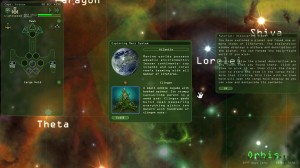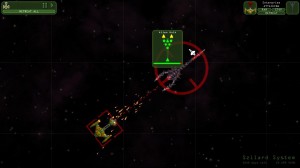To sum up “Weird Worlds: Return to Infinite Space”, you’re the Captain Kirk of the Purple Void galaxy. You’ve been tasked with going out and exploring this galaxy, though unlike “Star Trek”, you’ll be scored by how profitable and successful your mission is. It’s a mix of space exploration and combat…will you have what it takes to complete your mission and make a couple of credits in the process? Before we take a look at this game in further detail, I’d like to thank Iikka Keranen from Infinite Space Games for providing me with a free review copy.
You’ll be presented with a launcher before the game actually boots up, allowing you to adjust the screen resolution, toggle fullscreen, change the size of the UI (normal or large), and activate mods if you happen to have any. Once you’re in-game, you’ll have another options menu available that will allow you to adjust sound levels and toggle a few different interface / gameplay settings. There’s nothing fancy like motion blur, vsync, or even graphics quality settings, but these menus cover the basics. When you’re done setting things how you’d like, you can view scores, play around in the combat simulator, or start a new game. There’s no save option during the game and thus, no way to continue where you left off should you need to quit mid-game.
When you start a new game, you’ll be prompted to name your ship and captain, pick between three different ships, choose a map size, adjust nebula mass, and determine enemy strength. You’ll also be able to toggle tutorials on or off. After that, you’ll be presented with a mission briefing. Your primary objective will be to seek out and make first contact with alien races to see if they pose a threat, while your secondary objective is to acquire technologies, artifacts, and other miscellaneous information. You start out in the “Glory System”, but where that system lies in relation to other systems will change with every game. In other words, you’ll always start off in the same system, but the systems, events, and races around you will vary from game to game.
The interface is fairly straightforward. Tutorial information will show up on the right side of the screen if you have them enabled, and any important planetary discoveries or events will pop up in the middle. You’ll see your ship status and cargo on the left side of the screen, which you can hide or make visible via their respective buttons. You can also fast forward time and see what the current day, month, and year is. Keeping an eye on the time is important, since you’ll need to return to your home system and click the retire button before the date your mission was set to end. Small maps grant you ten years, medium maps grant you twenty years, and large maps grant you thirty years. For a quick five-minute game, small maps are the way to go. Larger maps can be over in ten to twenty minutes, depending on how quickly you click through screens and stop to read the text.
Since your mission is to seek out new life, you’ll need to get out there and explore. Clicking on any star system and hitting the engage button will take you there, so navigating the galaxy is easy enough. Time will tick by as you’re traveling, so it’s important to factor this in if you’re nearing the end of your mission’s time limit. System events vary, ranging from encountering races, engaging in combat, discovering crew members to add to your ship, finding valuable cargo/equipment, and more. If you manage to survive and make it back to your home planet to retire, you’ll be scored based on your performance. Being late grants you a penalty, so again, it’s important to be on time. You’ll also have an initial “mission cost” to overcome, so flying to one star system and coming back to retire generally won’t work if you’re aiming for a good score.
As fun as it is to explore new worlds and discover alien races, the game isn’t without its faults. Lack of a save feature, for example, can be inconvenient for a busy parent always on the go. Luckily, games set on the small galaxy setting usually don’t last very long. There is an initial difficulty curve to overcome and while there are tutorial messages, I don’t think they prepare the player enough for what they need to do. Even on the “easy” setting, I found myself outclassed by every hostile race I met. One of things I had to learn the hard way was that you’ll need to equip your ship with upgrades before you even think about going into combat. This leads me to currency…or lack thereof. You don’t earn credits during your travels. Rather, upgrading your ship or purchasing crew/equipment requires that you trade something already on your ship (cargo, etc.) for the item in question. Some items are more valuable than others, so you’ll need to pay attention to the number of “coins” listed on any particular item.
Overall, “Weird Worlds: Return to Infinite Space” is an interesting and fun diversion. I admit that I felt an overwhelming urge to play again (which I obliged), mainly because I was interested in seeing what new things I could discover that I hadn’t before. I was also compelled to see how I could do better, since the first five games I played resulted in a negative score. On the sixth game however, I hit about 6,000 points or so, having a full cargo load and a decent set of upgrades on my ship. Some might complain that the length of a game is short, but I honestly didn’t mind it considering my busy schedule. Those expecting a long and in-depth campaign a la “FTL” will be disappointed, but those going in looking for a quick “five-year mission” (yes, another Star Trek reference) fix may be pleasantly surprised.
Final Verdict: 8/10
—
You can learn more about and purchase “Weird Worlds: Return to Infinite Space” by visiting the following websites:
http://www.infinitespacegames.com/weirdworlds/
http://store.steampowered.com/app/226120/
http://www.desura.com/games/weird-worlds-return-to-infinite-space
You can check out gameplay videos here:
http://www.youtube.com/watch?v=erV-rjmLquE
http://www.youtube.com/watch?v=tsBDXu2xyVM
—



